TESLA MODEL S 2014 Owner's manual (Europe)
Manufacturer: TESLA, Model Year: 2014, Model line: MODEL S, Model: TESLA MODEL S 2014Pages: 152, PDF Size: 17.5 MB
Page 131 of 152
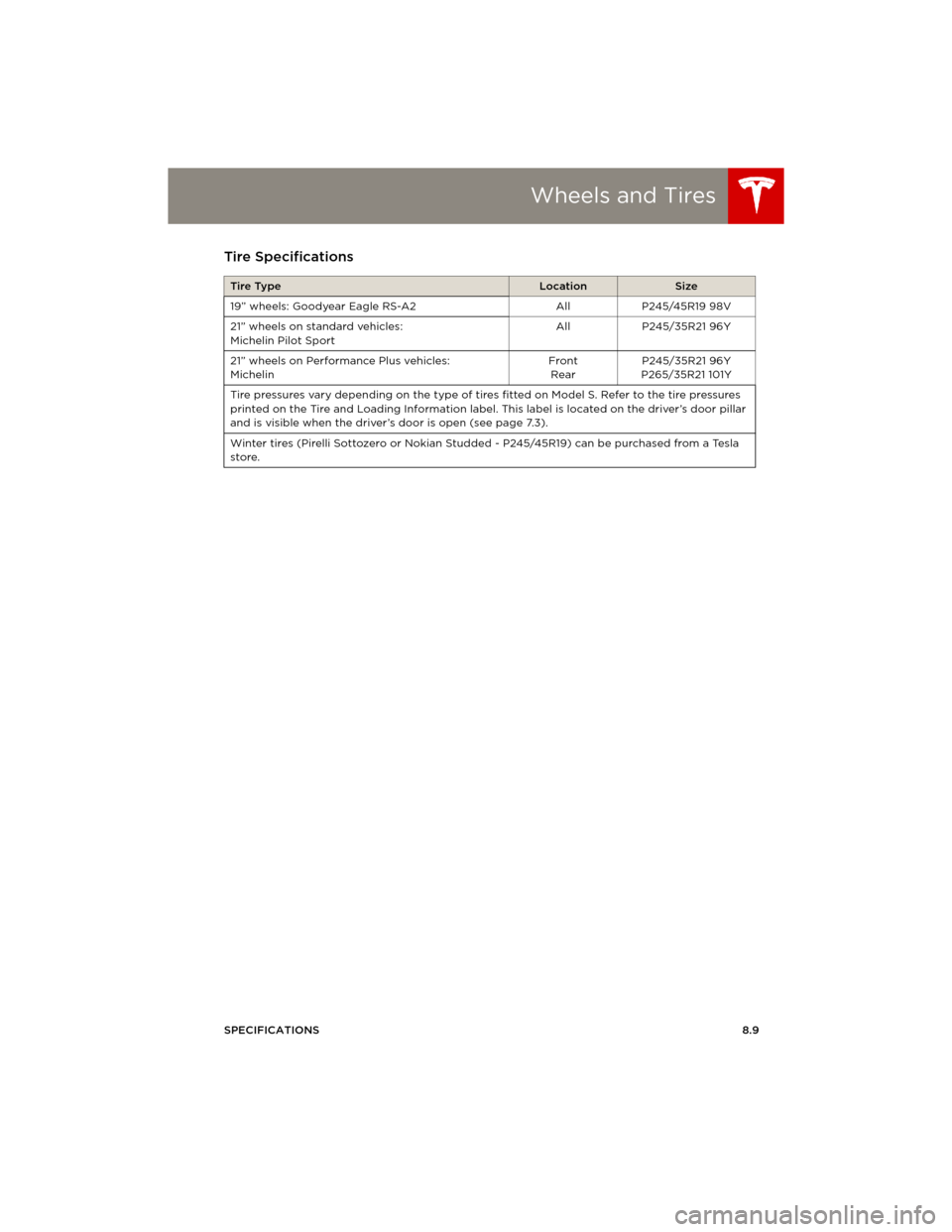
Wheels and Tires
SPECIFICATIONS8.9
Tire Specifications
Tire TypeLocationSize
19” wheels: Goodyear Eagle RS-A2 All P245/45R19 98V
21” wheels on standard vehicles:
Michelin Pilot Sport All P245/35R21 96Y
21” wheels on Performance Plus vehicles:
MichelinFront
RearP245/35R21 96Y
P265/35R21 101Y
Tire pressures vary depending on the type of tires fitted on Model S. Refer to the tire pressures
printed on the Tire and Loading Information label. This label is located on the driver’s door pillar
and is visible when the driver’s door is open (see page 7.3).
Winter tires (Pirelli Sottozero or Nokian Studded - P245/45R19) can be purchased from a Tesla
store.
book.book Page 9 Friday, July 19, 2013 12:53 PM
Page 132 of 152
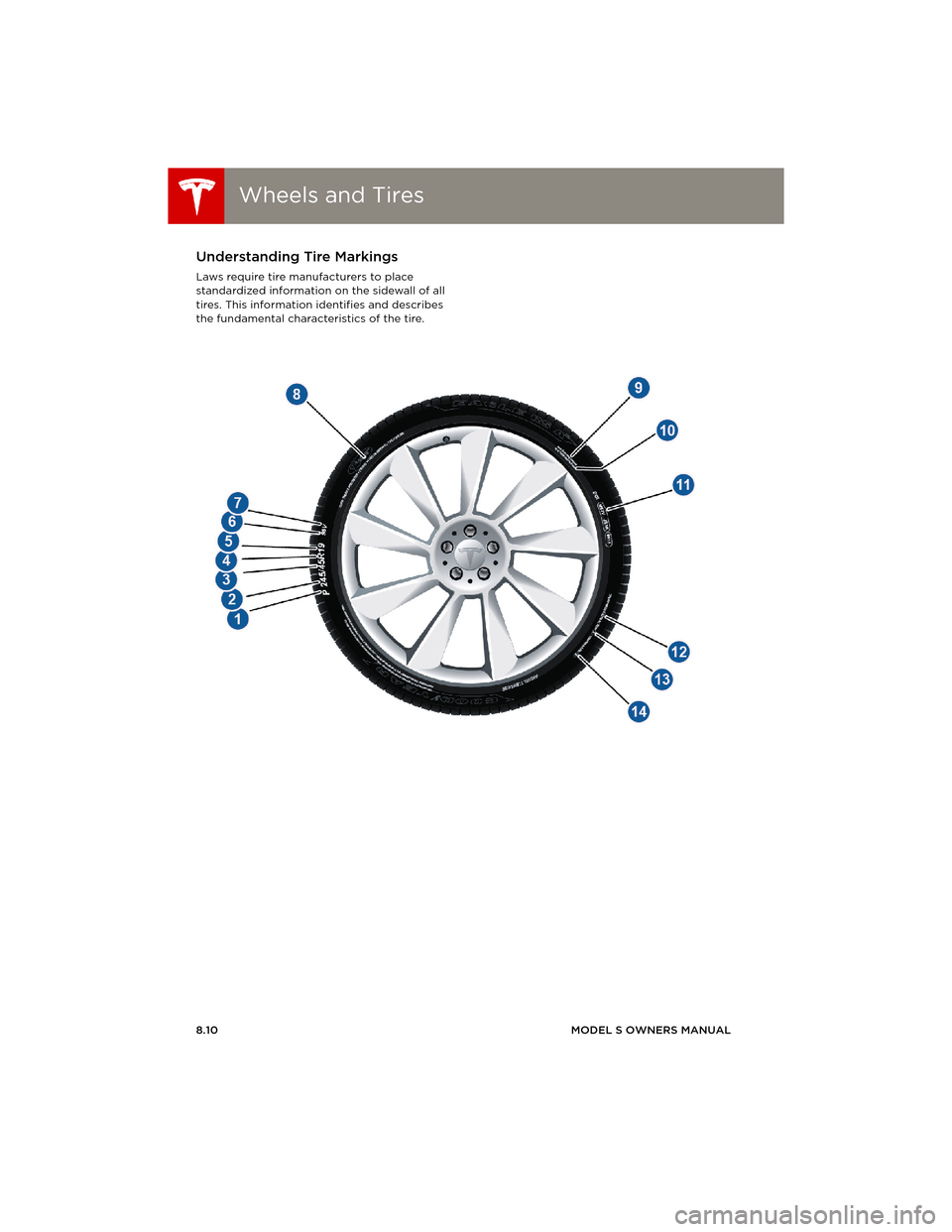
Wheels and TiresWheels and Tires
8.10MODEL S OWNERS MANUAL
Understanding Tire Markings
Laws require tire manufacturers to place
standardized information on the sidewall of all
tires. This information identifies and describes
the fundamental characteristics of the tire.
book.book Page 10 Friday, July 19, 2013 12:53 PM
Page 133 of 152
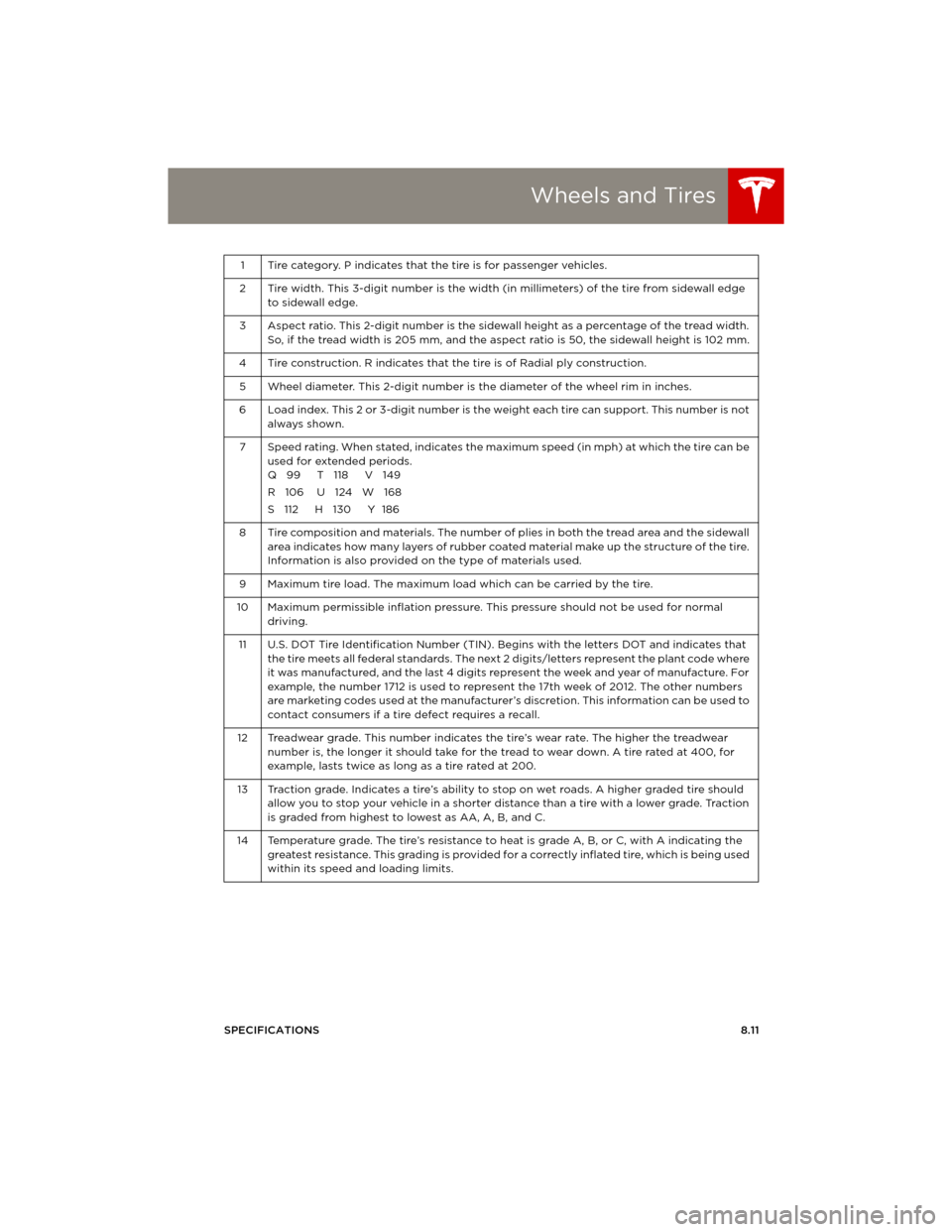
Wheels and Tires
SPECIFICATIONS8.11 1 Tire category. P indicates that the tire is for passenger vehicles.
2 Tire width. This 3-digit number is the width (in millimeters) of the tire from sidewall edge
to sidewall edge.
3 Aspect ratio. This 2-digit number is the sidewall height as a percentage of the tread width.
So, if the tread width is 205 mm, and the aspect ratio is 50, the sidewall height is 102 mm.
4 Tire construction. R indicates that the tire is of Radial ply construction.
5 Wheel diameter. This 2-digit number is the diameter of the wheel rim in inches.
6 Load index. This 2 or 3-digit number is the weight each tire can support. This number is not
always shown.
7 Speed rating. When stated, indicates the maximum speed (in mph) at which the tire can be
used for extended periods.
Q 99 T 118 V 149
R106 U124W168
S112 H130 Y186
8 Tire composition and materials. The number of plies in both the tread area and the sidewall
area indicates how many layers of rubber coated material make up the structure of the tire.
Information is also provided on the type of materials used.
9 Maximum tire load. The maximum load which can be carried by the tire.
10 Maximum permissible inflation pressure. This pressure should not be used for normal
driving.
11 U.S. DOT Tire Identification Number (TIN). Begins with the letters DOT and indicates that
the tire meets all federal standards. The next 2 digits/letters represent the plant code where
it was manufactured, and the last 4 digits represent the week and year of manufacture. For
example, the number 1712 is used to represent the 17th week of 2012. The other numbers
are marketing codes used at the manufacturer’s discretion. This information can be used to
contact consumers if a tire defect requires a recall.
12 Treadwear grade. This number indicates the tire’s wear rate. The higher the treadwear
number is, the longer it should take for the tread to wear down. A tire rated at 400, for
example, lasts twice as long as a tire rated at 200.
13 Traction grade. Indicates a tire’s ability to stop on wet roads. A higher graded tire should
allow you to stop your vehicle in a shorter distance than a tire with a lower grade. Traction
is graded from highest to lowest as AA, A, B, and C.
14 Temperature grade. The tire’s resistance to heat is grade A, B, or C, with A indicating the
greatest resistance. This grading is provided for a correctly inflated tire, which is being used
within its speed and loading limits.
book.book Page 11 Friday, July 19, 2013 12:53 PM
Page 134 of 152

book.book Page 12 Friday, July 19, 2013 12:53 PM
Page 135 of 152
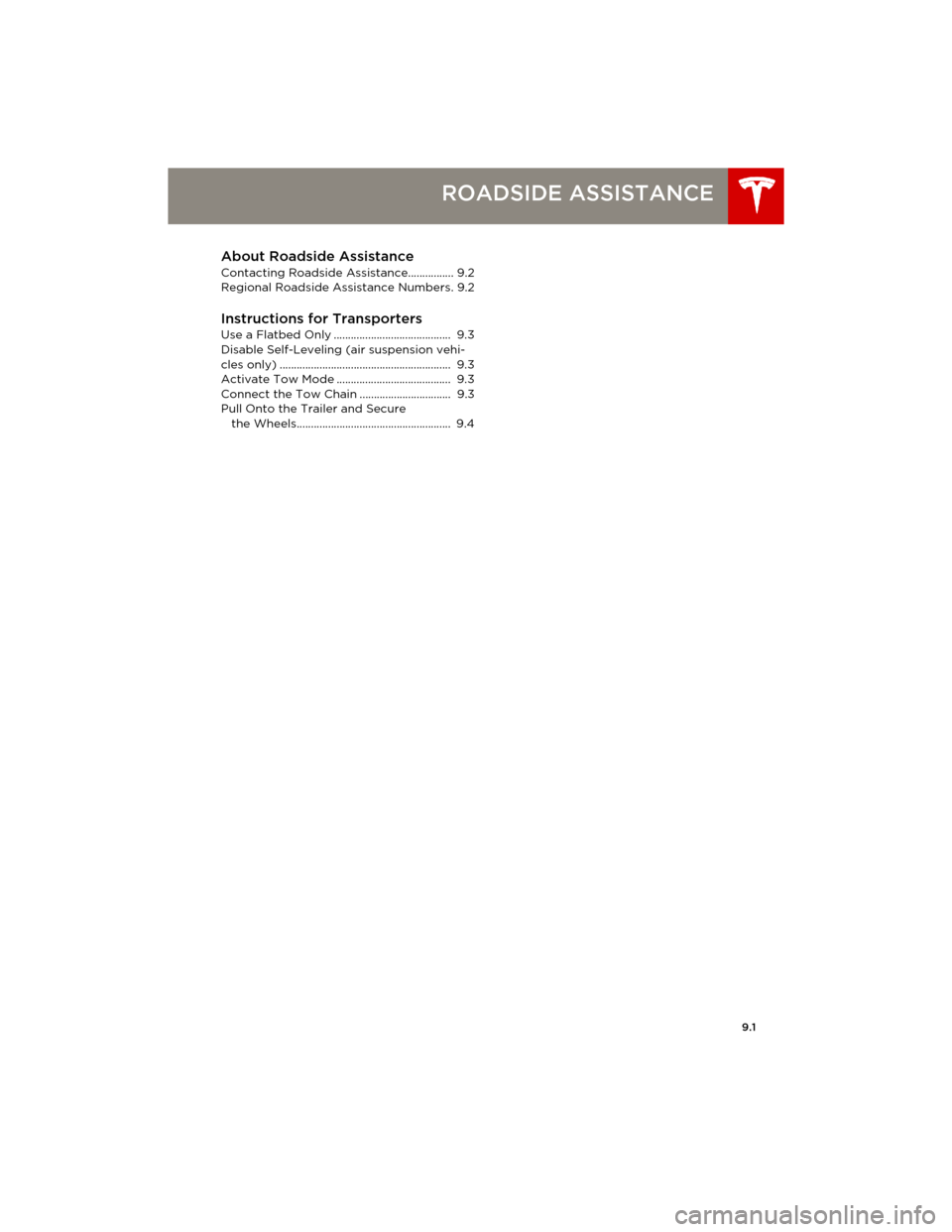
9.1
ROADSIDE ASSISTANCE
About Roadside Assistance
Contacting Roadside Assistance................ 9.2
Regional Roadside Assistance Numbers. 9.2
Instructions for TransportersUse a Flatbed Only ......................................... 9.3
Disable Self-Leveling (air suspension vehi-
cles only) ............................................................ 9.3
Activate Tow Mode ........................................ 9.3
Connect the Tow Chain ................................ 9.3
Pull Onto the Trailer and Secure
the Wheels...................................................... 9.4
book.book Page 1 Friday, July 19, 2013 12:53 PM
Page 136 of 152

About Roadside AssistanceAbout Roadside Assistance
9.2MODEL S OWNERS MANUAL
ROADSIDE ASSISTANCE
About Roadside AssistanceContacting Roadside Assistance
Tesla Roadside Assistance is available to you,
24 hours a day, 365 days a year for the duration
of your warranty period.
To contact Roadside Assistance, call the
number for your region, listed on this page.
Advise the representative of the vehicle
identification number (VIN), license plate
number, mileage, your location, and the nature
of the problem. The VIN is on the upper
dashboard on the driver’s side of your vehicle
and is visible through the windshield.
For a complete description of the terms and
conditions of the Tesla Roadside Assistance
Program, refer to the policy that was provided
to you by Tesla when you purchased Model S.
It is your responsibility to provide vehicle
transporters with instructions on how to
transport Model S (see page 9.3).
Regional Roadside Assistance
Numbers
A toll free number is available in most European
regions. If a toll free number is not listed below,
go to www.teslamotors.com to check if a toll
free number has become available in your area.
Andorra (Toll) . . . . . . . . . . . . + 31 (0)13 799 9501
Andorra (Toll Free) . . . . . . . . . . + 0800 914 590
Austria (Toll) . . . . . . . . . . . . + 31 (0)13 799 9502
Austria (Toll Free) . . . . . . . . . . + 0800 88 0992
Belgium (Toll) . . . . . . . . . . . + 31 (0)13 799 9503
Belgium (Toll Free) . . . . . . . . . . . + 0800 29 027
Bulgaria (Toll) . . . . . . . . . . . + 31 (0)13 799 9504
Croatia (Toll) . . . . . . . . . . . . + 31 (0)13 799 9505
Cyprus (Toll) . . . . . . . . . . . . + 31 (0)13 799 9506
Czech Republic (Toll) . . . . + 31 (0)13 799 9507
Denmark (Toll) . . . . . . . . . . + 31 (0)13 799 9508
Denmark (Toll Free) . . . . . . . . . . . . + 800 71 1024
Estonia (Toll) . . . . . . . . . . . . + 31 (0)13 799 9509
Finland (Toll) . . . . . . . . . . . . . + 31 (0)13 799 9510
France (Toll) . . . . . . . . . . . . . + 31 (0)13 799 9511
France (Toll Free) . . . . . . . . . . . . + 0800 94 1029
Germany (Toll) . . . . . . . . . . . + 31 (0)13 799 9512
Germany (Toll Free) . . . . . . . . . + 0800 5893542
Gibraltar . . . . . . . . . . . . . . . . . + 31 (0)13 799 9513
Greece (Toll) . . . . . . . . . . . . . + 31 (0)13 799 9514Greece (Toll Free) . . . . + 0800 1809 205 0645
Hungary (Toll) . . . . . . . . . . . . + 31 (0)13 799 9515
Iceland (Toll) . . . . . . . . . . . . . + 31 (0)13 799 9516
Ireland (Toll) . . . . . . . . . . . . . + 31 (0)13 799 9517
Italy (Toll) . . . . . . . . . . . . . . . + 31 (0)13 799 9518
Italy (Toll Free) . . . . . . . . . . . . . . . + 800 122 709
Latvia . . . . . . . . . . . . . . . . . . . + 31 (0)13 799 9519
Liechtenstein (Toll) . . . . . . + 31 (0)13 799 9520
Liechtenstein (Toll Free) . . . . . . + 0800 558 847
Lithuania (Toll) . . . . . . . . . . . + 31 (0)13 799 9521
Luxembourg (Toll) . . . . . . . . + 31 (0)13 799 9522
Luxembourg (Toll Free) . . . + 0800 8002 2538
Malta (Toll) . . . . . . . . . . . . . + 31 (0)13 799 9523
Monaco (Toll) . . . . . . . . . . . . + 31 (0)13 799 9524
Monaco (Toll Free) . . . . . . . . . . . + 0800 94 1029
Netherlands (Toll) . . . . . . . . + 31 (0)13 799 9525
Netherlands (Toll Free) . . . . . . + 0800 0200160
Norway (Toll) . . . . . . . . . . . . + 31 (0)13 799 9527
Norway (Toll Free) . . . . . . . . . . . . . . + 800 11 093
Poland (Toll) . . . . . . . . . . . . + 31 (0)13 799 9528
Poland (Toll Free). . . . . . . . . . . . + 800 141 01492
Portugal (Toll) . . . . . . . . . . . . + 31 (0)13 799 9529
Romania (Toll) . . . . . . . . . . + 31 (0)13 799 9530
San Marino (Toll) . . . . . . . . . + 31 (0)13 799 9531
Slovakia (Toll) . . . . . . . . . . . . + 31 (0)13 799 9532
Slovenia (Toll) . . . . . . . . . . . . + 31 (0)13 799 9533
Spain (Toll) . . . . . . . . . . . . . .+ 31 (0)13 799 9534
Sweden (Toll) . . . . . . . . . . . . + 31 (0)13 799 9535
Switzerland (Toll) . . . . . . . . .+ 31 (0)13 799 9536
Switzerland (Toll Free) . . . . . . . + 0800 83 7521
United Kingdom (Toll). . . . . + 31 (0)13 799 9537
United Kingdom (Toll Free) . . + 0800 358 5774
assistance.fm Page 2 Thursday, July 25, 2013 10:59 AM
Page 137 of 152
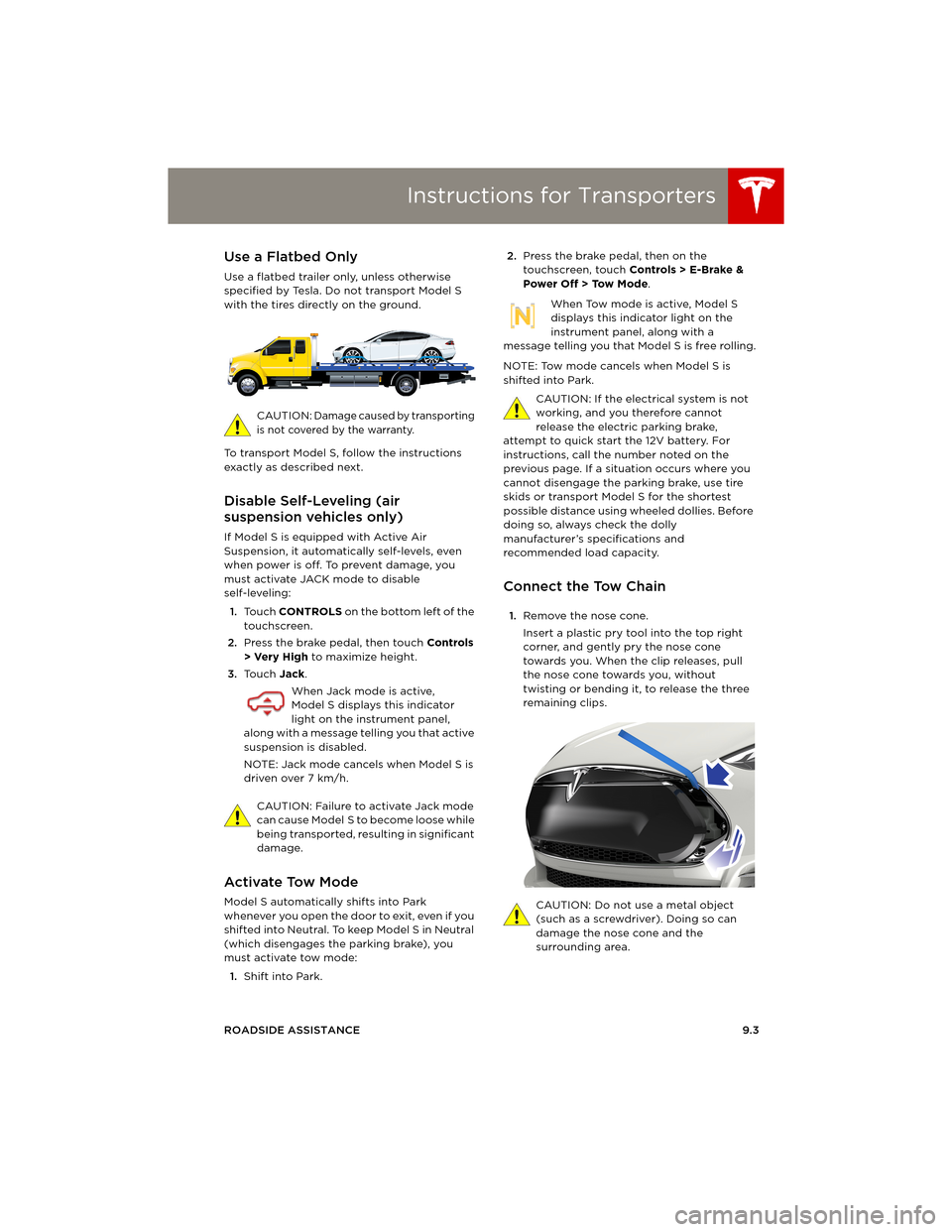
Instructions for Transporters
ROADSIDE ASSISTANCE9.3
Instructions for TransportersUse a Flatbed Only
Use a flatbed trailer only, unless otherwise
specified by Tesla. Do not transport Model S
with the tires directly on the ground.
CAUTION:
D a m a g e c a u s e d b y t r a n s p o r t i n g
is not covered by the warranty.
To transport Model S, follow the instructions
exactly as described next.
Disable Self-Leveling (air
suspension vehicles only)
If Model S is equipped with Active Air
Suspension, it automatically self-levels, even
when power is off. To prevent damage, you
must activate JACK mode to disable
self-leveling:
1.To u c h CONTROLS on the bottom left of the
touchscreen.
2.Press the brake pedal, then touch Controls
> Very High to maximize height.
3.To u c h Jack.
When Jack mode is active,
Model S displays this indicator
light on the instrument panel,
along with a message telling you that active
suspension is disabled.
NOTE: Jack mode cancels when Model S is
driven over 7 km/h.
CAUTION: Failure to activate Jack mode
can cause Model S to become loose while
being transported, resulting in significant
damage.
Activate Tow Mode
Model S automatically shifts into Park
whenever you open the door to exit, even if you
shifted into Neutral. To keep Model S in Neutral
(which disengages the parking brake), you
must activate tow mode:
1.Shift into Park.2.Press the brake pedal, then on the
touchscreen, touch Controls > E-Brake &
Power Off > Tow Mode.
When Tow mode is active, Model S
displays this indicator light on the
instrument panel, along with a
message telling you that Model S is free rolling.
NOTE: Tow mode cancels when Model S is
shifted into Park.
CAUTION:
If the electrical system is not
working, and you therefore cannot
release the electric parking brake,
attempt to quick start the 12V battery. For
instructions, call the number noted on the
previous page. If a situation occurs where you
cannot disengage the parking brake, use tire
skids or transport Model S for the shortest
possible distance using wheeled dollies. Before
doing so, always check the dolly
manufacturer’s specifications and
recommended load capacity.
Connect the Tow Chain
1.Remove the nose cone.
Insert a plastic pry tool into the top right
corner, and gently pry the nose cone
towards you. When the clip releases, pull
the nose cone towards you, without
twisting or bending it, to release the three
remaining clips.
CAUTION: Do not use a metal object
(such as a screwdriver). Doing so can
damage the nose cone and the
surrounding area.
book.book Page 3 Friday, July 19, 2013 12:53 PM
Page 138 of 152
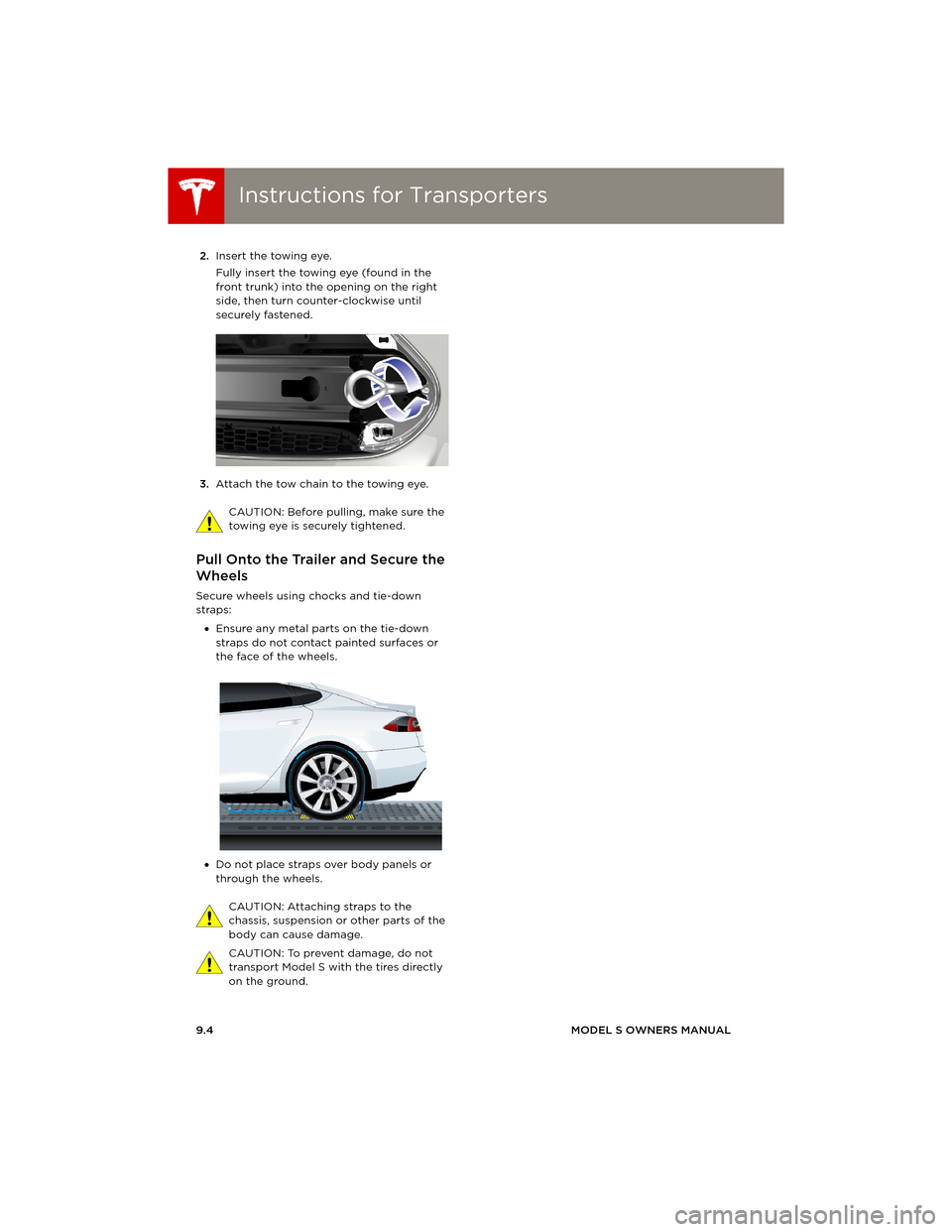
Instructions for TransportersInstructions for Transporters
9.4MODEL S OWNERS MANUAL 2.Insert the towing eye.
Fully insert the towing eye (found in the
front trunk) into the opening on the right
side, then turn counter-clockwise until
securely fastened.
3.Attach the tow chain to the towing eye.
CAUTION: Before pulling, make sure the
towing eye is securely tightened.
Pull Onto the Trailer and Secure the
Wheels
Secure wheels using chocks and tie-down
straps:
•Ensure any metal parts on the tie-down
straps do not contact painted surfaces or
the face of the wheels.
•Do not place straps over body panels or
through the wheels.
CAUTION: Attaching straps to the
chassis, suspension or other parts of the
body can cause damage.
CAUTION: To prevent damage, do not
transport Model S with the tires directly
on the ground.
book.book Page 4 Friday, July 19, 2013 12:53 PM
Page 139 of 152
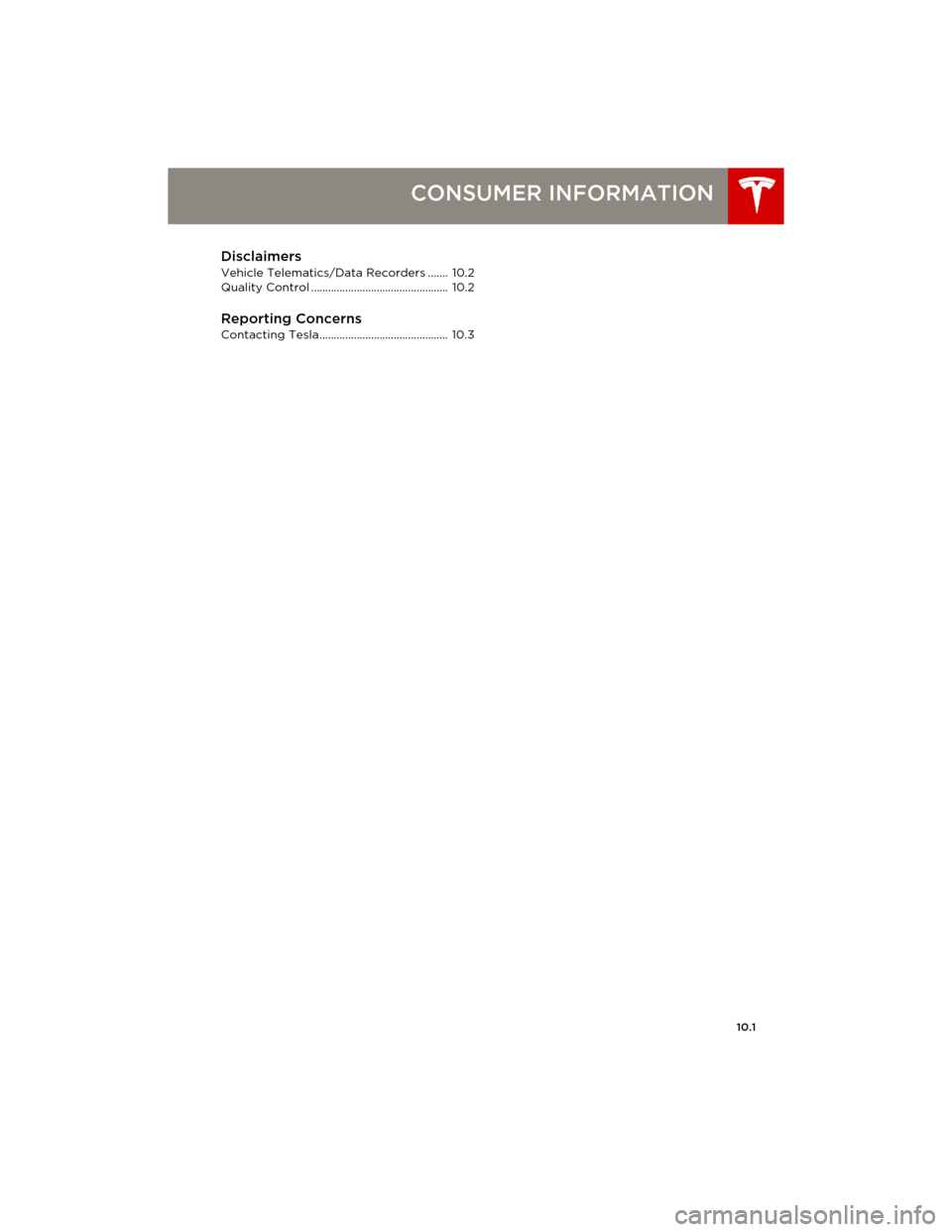
10.1
CONSUMER INFORMATION
Disclaimers
Vehicle Telematics/Data Recorders ....... 10.2
Quality Control ................................................ 10.2
Reporting ConcernsContacting Tesla ............................................. 10.3
book.book Page 1 Friday, July 19, 2013 12:53 PM
Page 140 of 152
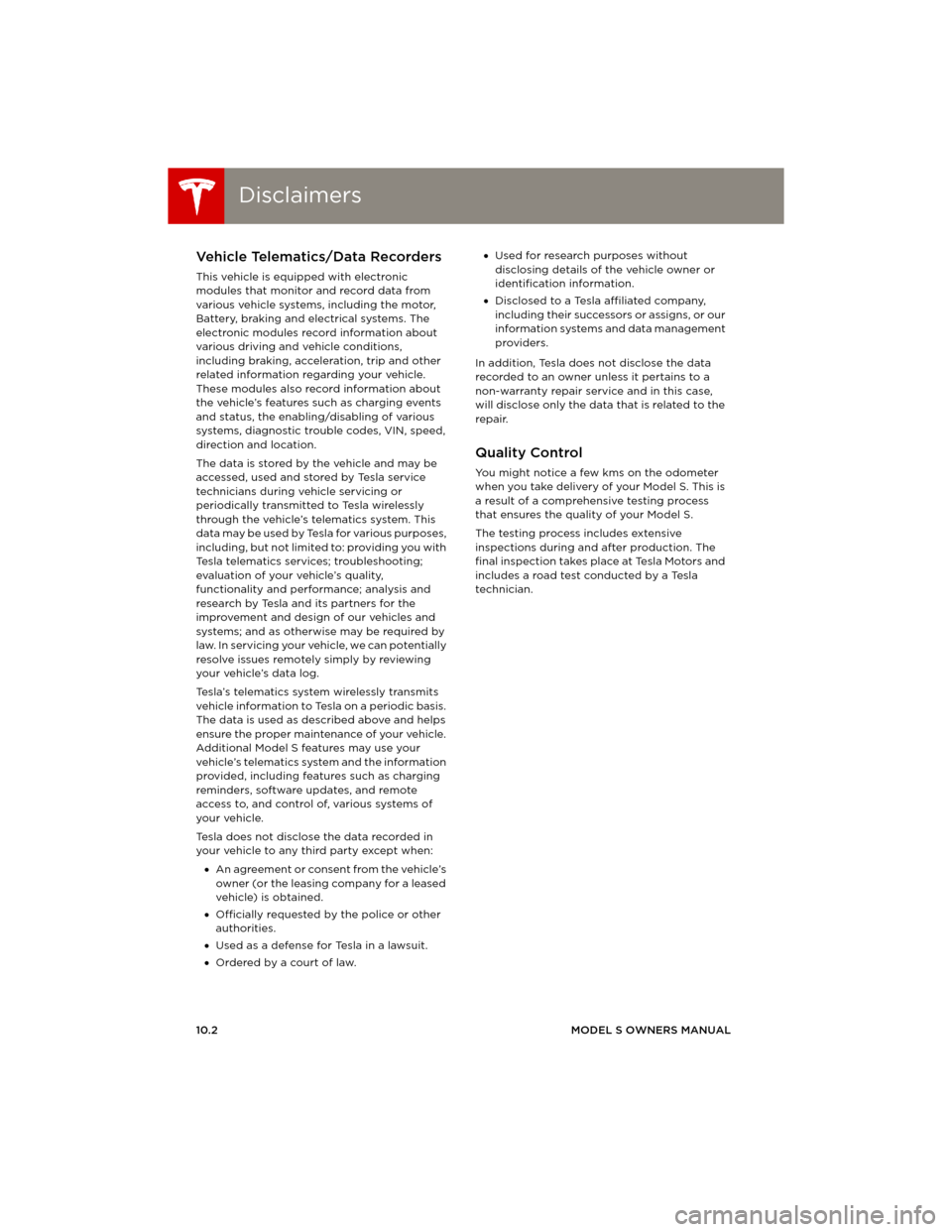
DisclaimersDisclaimers
10.2MODEL S OWNERS MANUAL
CONSUMER INFORMATION
DisclaimersVehicle Telematics/Data Recorders
This vehicle is equipped with electronic
modules that monitor and record data from
various vehicle systems, including the motor,
Battery, braking and electrical systems. The
electronic modules record information about
various driving and vehicle conditions,
including braking, acceleration, trip and other
related information regarding your vehicle.
These modules also record information about
the vehicle’s features such as charging events
and status, the enabling/disabling of various
systems, diagnostic trouble codes, VIN, speed,
direction and location.
The data is stored by the vehicle and may be
accessed, used and stored by Tesla service
technicians during vehicle servicing or
periodically transmitted to Tesla wirelessly
through the vehicle’s telematics system. This
data may be used by Tesla for various purposes,
including, but not limited to: providing you with
Tesla telematics services; troubleshooting;
evaluation of your vehicle’s quality,
functionality and performance; analysis and
research by Tesla and its partners for the
improvement and design of our vehicles and
systems; and as otherwise may be required by
law. In servicing your vehicle, we can potentially
resolve issues remotely simply by reviewing
your vehicle’s data log.
Tesla’s telematics system wirelessly transmits
vehicle information to Tesla on a periodic basis.
The data is used as described above and helps
ensure the proper maintenance of your vehicle.
Additional Model S features may use your
vehicle’s telematics system and the information
provided, including features such as charging
reminders, software updates, and remote
access to, and control of, various systems of
your vehicle.
Tesla does not disclose the data recorded in
your vehicle to any third party except when:
•An agreement or consent from the vehicle’s
owner (or the leasing company for a leased
vehicle) is obtained.
•Officially requested by the police or other
authorities.
•Used as a defense for Tesla in a lawsuit.
•Ordered by a court of law.•Used for research purposes without
disclosing details of the vehicle owner or
identification information.
•Disclosed to a Tesla affiliated company,
including their successors or assigns, or our
information systems and data management
providers.
In addition, Tesla does not disclose the data
recorded to an owner unless it pertains to a
non-warranty repair service and in this case,
will disclose only the data that is related to the
repair.
Quality Control
You might notice a few kms on the odometer
when you take delivery of your Model S. This is
a result of a comprehensive testing process
that ensures the quality of your Model S.
The testing process includes extensive
inspections during and after production. The
final inspection takes place at Tesla Motors and
includes a road test conducted by a Tesla
technician.
book.book Page 2 Friday, July 19, 2013 12:53 PM